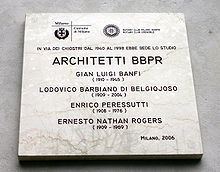Founded 1932 | ||
 | ||
BBPR was an architectural partnership founded in Milan, Italy in 1932.
The partners were:
From each member's family name, came the acronym "BBPR".
The BBPR studio was formed in Milan in 1932 in a climate described by Ciucci as “oscillating between differing and contrasting positions.” Their contribution to the development of Rationalism is evident not only in their architecture but in their involvement with MIAR and the journal Quadrante born as a rival to Casabella. Their work held general appeal and was also appreciated and promoted by Edoardo Persico and Giuseppe Pagano at Casabella. Along with the editor Valentino Bompiani, the BBPR group is credited for the original idea for the Italian Civilisation building. The selection of the Guerrini-La Padula-Romano project was fraught with polemics since it is argued that their eulogy to the most Roman of architectural motif - the arch - is what won them first prize, a prize which some say deservedly belonged to the Milanese architects. Their adherence to Fascism was short-lived and they soon became members of the resistance: Banfi and Belgiojoso were imprisoned at the Mathausen concentration camp where Banfi died and Rogers, being of Jewish descent, was forced into exile in Switzerland.
The practice continued under the same name after the Second World War despite the death of Banfi in Mauthausen concentration camp.
The firm came to notice after World War II with the abstract design for the Monument to the Victims of Nazi Concentration Camps, erected within the Cimitero Monumentale di Milano.
BBPR reacted against the polemic of the International Style in 1954, with the creation of the Torre Velasca in Milan, complete with its abstract medieval references. The tower responds to its prominent location near the Milan Cathedral in the city's historic centre.
The firm were subsequently employed to create new interior spaces and exhibition designs for the museums housed within Milan's Castello Sforzesco which had been severely damaged by allied bombing in 1943.
